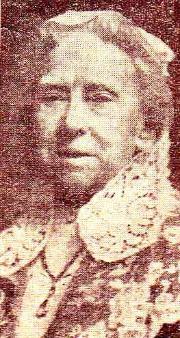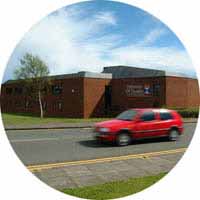A Brief History of the School of Nursing & Midwifery
by John Drummond, School of Nursing & Midwifery

Rebecca Strong
In the early 20th century, after the Midwives Registration Act of 1901 and the Nurses' Registration Act of 1911, and the formation of the General Nursing and Midwifery Councils in the 1930s, schools of nursing and schools of midwifery were attached to different local hospitals under their respective Boards of Management. Each hospital school had its own distinctive uniforms, training programmes and badges. Students were employees of the hospital and worked the normal shifts for that hospital. They also lived in the hospital residences, or nurses' homes under the supervision of the 'Home Sister', a system started by Florence Nightingale in 1861 at St Thomas's Hospital in London.
The training programme in the different hospital schools was of the 'block' apprenticeship type. This consisted of short periods of instruction in the school, followed by periods of practice in the various wards of the local hospital. The block system of training for nurses was initiated by Rebecca Strong in 1893 at Glasgow Royal Infirmary and became adopted across Europe, the United States and other countries of the world. Rebecca Strong, a former pupil of Florence Nightingale, had been Matron at Dundee Royal Infirmary from 1874-79.
The attachment of schools to local hospitals continued up until the mid to late 1960s. It was then that schools in Tayside and Fife began to merge into larger schools under the government of the local Health Boards and no longer the hospital Boards of Management. This gave rise to Perth College of Nursing and Midwifery, Angus College of Nursing, Dundee College of Nursing and Midwifery and also the College of Nursing and Midwifery in Kirkcaldy. Student nurses and midwives became employees of the Health Boards.

Student nurses at Barnhill, 1966
In the mid 1980s further mergers took place resulting in what became Fife College of Health Studies at the present campus in Kirkcaldy, and Tayside College of Nursing and Midwifery on the present Ninewells campus in Dundee. During this time preparations were made by both Colleges for the move of nursing and midwifery into the higher education sector. In 1992, the initial qualifying award for nurses and midwives was changed from a certificate to a higher education diploma. This was followed by further preparations for a move of nursing and midwifery education, involving both staff and students in Tayside and Fife into the University.
In 1996, the former Fife College of Health Studies and Tayside College of Nursing and Midwifery merged to become the present School of Nursing and Midwifery of the Faculty of Medicine, Dentistry and Nursing of the University of Dundee. The School of Nursing and Midwifery is one of the largest Schools in the University. It has three main campuses: the Ninewells campus, the Fife campus and on the main campus in Airlie Place. Since becoming part of the University in 1996, the School has moved from strength to strength through three main phases.



The first phase, from 1996 to 2001 was largely a period of transition into the Faculty and University in terms both of teaching and the gradual development of a research infrastructure. This phase saw a significant increase in the number of students as efforts were made to integrate students into the University culture. Developments also took place in the Clinical Skills Centre at Ninewells, including an expansion of the Centre and shared learning between nursing, midwifery and medical students. This phase culminated in the development of new programmes which, for the first time in the School, saw the award of pre-registration degrees in nursing and midwifery respectively, along with a more robust strategy for partnership in strategic development with service colleagues across Fife and Tayside.
The second phase, from 2001 to 2004, was a period of dynamic and highly productive development on a number of fronts. The School integrated further onto the main campus of the University with a new site in Airlie Place. This was in parallel with site improvements in student amenities on the Ninewells and Kirkcaldy campuses. One of the main developments during this period was a considerable expansion in research activity, including both funding and publication output. This was accompanied by a considerable expansion in the School's postgraduate provision and in the supervision of higher research degrees. The second phase also saw the birth of the Social Dimensions of Health Institute in collaboration with the University of St. Andrews.
The School is currently in the early stage of phase three. Carrying forward the considerable achievements of phase two, this will see the commencement of new undergraduate programmes in nursing and midwifery along with a new research strategy that will consolidate and develop identified and expanding programmes of research. There are also plans to expand the School's presence in Airlie Place and to carry out more teaching on the main campus. Postgraduate activity will increase along with the continuing enrichment of partnership with service colleagues. Phase three will also see the School enter the Research Assessment Exercise for the first time.
The School, while acknowledging and proud of its history, is also forward looking in its aspirations. It strives to be an asset to its students, clinical partners, the Faculty, the University and the communities which it serves. This will be conducted through its three related themes of collaboration, integration and growth.